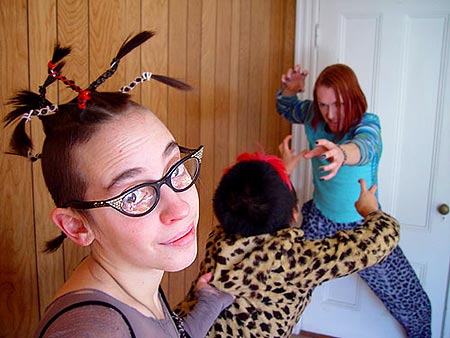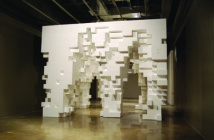You’re walking through the city at 3 AM. It’s pitch black; it’s silent; you’re alone on the streets. You turn a corner and see a car in flames. Bodies burn before your eyes; the metal hull of the car has been torn open. There was no sound of a crash—no explosion—just a bonfire of flesh and metal. Maybe it’s a joke, some kind of a hoax. But what should you do? What can you do? You turn your head, and to your surprise, you’re among a hundred strangers. They’re frozen, leaning forward, eyes wide, transfixed by the flames. Is this how you looked a moment ago? You turn back to the crash, and the flames go out. The bodies stand up and walk away, unconcerned.
This is what it’s like to witness performance art and dance choreographed by Alisia L L Waller.
My first experience with Ms. Waller’s work was in 2008, when I attended a Shared Choreographers’ Concert at The Dance Complex in Cambridge, Massachusetts. I’d been to enough dance concerts to know the drill: See a couple of solos and a few group pieces— choreographed either to pop or classical music—that vary in both quality and maturity. When Ms. Waller’s “(do not) go gentle” began, I was unprepared for the violence and screaming of three women embroiled in a struggle for survival as a lone musician calmly mixed music at the edge of the stage.
At one point, I investigated the rest of the audience and realized we were as much a part of the production as the performers. Some of us were horrified; others were on the verge of laughter while several of us surveyed the room with a questioning eye. All of us were unsure of ourselves and uncomfortable with our own thoughts and reactions. Was it right to like this? Was it right to laugh?
During any other piece, protocol dictates that I sit there and smile, wait for the lights to go out, and then, when they come back on, clap and smile once again. Whether I think the piece is brilliant art or tragic self-indulgence is beside the point. I know how I’m supposed to behave. But during Ms. Waller’s piece, I found that for the first time that night, the audience was unprepared. It had never learned its own choreography for this kind of performance.
My second experience with Ms. Waller’s work was at another Shared Choreographers’ Concert. In “Control Efforts: Ongoing (variable: candy),” a female performer randomly pulls audience members onto the dance floor and, without words, coaxes them into performing simple actions in exchange for candy. The third or fourth audience member isn’t allowed to leave, though. As she tries to return to her seat, the performer pulls her back onto the stage, and slowly a fight ensues, eventually degenerating into an ugly, demeaning attempt for control as the performer forces a dog collar onto the woman.
Granted, at this point the audience had figured out that the woman being collared was actually a performer, but the impact had already been made. In starting the performance with actual spectators, Ms. Waller closes the distance between the audience and the performance. The woman being collared and beaten is one of us. She’s someone’s sister or wife; she’s someone’s mother or daughter. The result is similar to that of witnessing someone you know doing something despicable in one of your dreams. When you wake up, you realize it was all a dream, yet you find yourself angry at that person anyway, and it takes time for the feeling, as unjustified as it is, to dissipate.
My third, and most recent, experience with Ms. Waller’s work was at the Juddertone concert in Boston. Unlike the other two performances choreographed by Ms. Waller, “Anima or: Anthrozoology” isn’t particularly violent. It is, however, a surreal—or perhaps expressionist—piece of art that incorporates a woman with an animal claw, a tall, slender, white creature with a long bill, and a long, cloud-like creature operated by three performers that could have been pulled from the mind of Hayao Miyazaki. As no description could possibly do the piece justice, I’ll focus on a particularly interesting reaction by the audience.
At one point, the cloud-like creature moved slowly, patiently offstage, to the side of the auditorium, and walked out one of the exit doors. As this happened, the audience began to laugh, most likely because of the odd juxtaposition of this fantastical creature moving into the audience’s space and performing a mundane task, almost as if we’d caught the creature behind the building on a smoke break.
After the performance, I spoke with Ms. Waller about the show, and she mentioned the audience’s laughter, saying, “I didn’t expect that.” For a moment, I was uncomfortable, thinking that perhaps she was insulted by the laughter. After all, an audience laughing at your work can be a terrible experience, yet she quickly added, “But I thought it was great.”
Convinced she was being honest with me, I realized what makes Ms. Waller’s pieces different from other performance art I’ve seen: they don’t communicate with in the same transparent, heavy-handed way that most performance art does. Instead, watching a piece by Ms. Waller is like being dropped onto an alien planet. As you watch the bizarre and unfamiliar activity around you, it doesn’t matter whether you approve of it or not—whether you think it’s beautiful or funny. As long as you’re on that planet, you’re the outsider, and the inhabitants don’t want or need your approval. So as you watch them move and play strangely, and you feel anger or laughter growing within you, take the opportunity to ask yourself why they make you feel the way you do.
- Alisia Waller, Han Yu & luQ (L-R) in a press photo by Jonathan McIntosh.
- Alisia Waller and Jenn Pipp (L-R) demonstrate corporate desperation for “ConglomoCo. Employee Appreciation Night.” Photo by Justin McIntosh.
- Alisia Waller (x3) performing in “Riot” at Mobius’ Movement Works in Progress. Photo by Bob Raymond.
The And So No Sin Performance Troupe
All images are courtesy of the artist's website.







